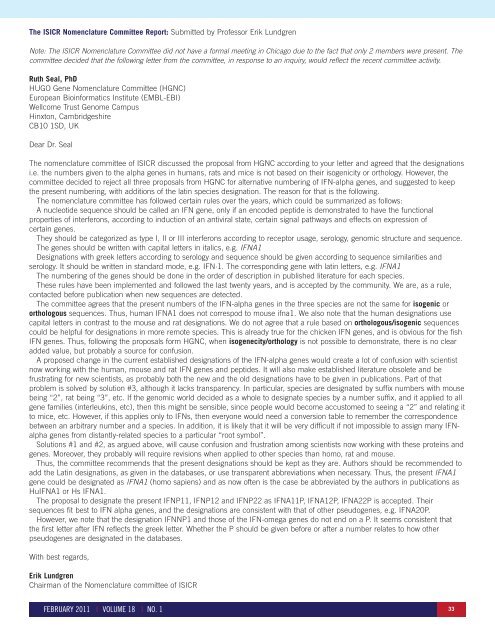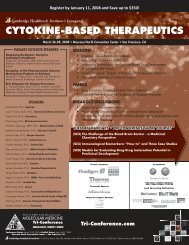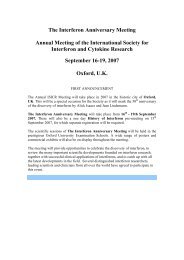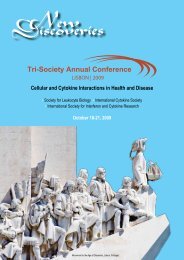9th Joint Meeting ISICR-ICS Cytokines & Interferons: From the ...
9th Joint Meeting ISICR-ICS Cytokines & Interferons: From the ...
9th Joint Meeting ISICR-ICS Cytokines & Interferons: From the ...
You also want an ePaper? Increase the reach of your titles
YUMPU automatically turns print PDFs into web optimized ePapers that Google loves.
The <strong>ISICR</strong> Nomenclature Committee Report: Submitted by Professor Erik Lundgren<br />
Note: The <strong>ISICR</strong> Nomenclature Committee did not have a formal meeting in Chicago due to <strong>the</strong> fact that only 2 members were present. The<br />
committee decided that <strong>the</strong> following letter from <strong>the</strong> committee, in response to an inquiry, would reflect <strong>the</strong> recent committee activity.<br />
Ruth Seal, PhD<br />
HUGO Gene Nomenclature Committee (HGNC)<br />
European Bioinformatics Institute (EMBL-EBI)<br />
Wellcome Trust Genome Campus<br />
Hinxton, Cambridgeshire<br />
CB10 1SD, UK<br />
Dear Dr. Seal<br />
The nomenclature committee of <strong>ISICR</strong> discussed <strong>the</strong> proposal from HGNC according to your letter and agreed that <strong>the</strong> designations<br />
i.e. <strong>the</strong> numbers given to <strong>the</strong> alpha genes in humans, rats and mice is not based on <strong>the</strong>ir isogenicity or orthology. However, <strong>the</strong><br />
committee decided to reject all three proposals from HGNC for alternative numbering of IFN-alpha genes, and suggested to keep<br />
<strong>the</strong> present numbering, with additions of <strong>the</strong> latin species designation. The reason for that is <strong>the</strong> following.<br />
The nomenclature committee has followed certain rules over <strong>the</strong> years, which could be summarized as follows:<br />
A nucleotide sequence should be called an IFN gene, only if an encoded peptide is demonstrated to have <strong>the</strong> functional<br />
properties of interferons, according to induction of an antiviral state, certain signal pathways and effects on expression of<br />
certain genes.<br />
They should be categorized as type I, II or III interferons according to receptor usage, serology, genomic structure and sequence.<br />
The genes should be written with capital letters in italics, e.g. IFNA1<br />
Designations with greek letters according to serology and sequence should be given according to sequence similarities and<br />
serology. It should be written in standard mode, e.g. IFN·1. The corresponding gene with latin letters, e.g. IFNA1<br />
The numbering of <strong>the</strong> genes should be done in <strong>the</strong> order of description in published literature for each species.<br />
These rules have been implemented and followed <strong>the</strong> last twenty years, and is accepted by <strong>the</strong> community. We are, as a rule,<br />
contacted before publication when new sequences are detected.<br />
The committee agrees that <strong>the</strong> present numbers of <strong>the</strong> IFN-alpha genes in <strong>the</strong> three species are not <strong>the</strong> same for isogenic or<br />
orthologous sequences. Thus, human IFNA1 does not correspod to mouse ifna1. We also note that <strong>the</strong> human designations use<br />
capital letters in contrast to <strong>the</strong> mouse and rat designations. We do not agree that a rule based on orthologous/isogenic sequences<br />
could be helpful for designations in more remote species. This is already true for <strong>the</strong> chicken IFN genes, and is obvious for <strong>the</strong> fish<br />
IFN genes. Thus, following <strong>the</strong> proposals form HGNC, when isogenecity/orthology is not possible to demonstrate, <strong>the</strong>re is no clear<br />
added value, but probably a source for confusion.<br />
A proposed change in <strong>the</strong> current established designations of <strong>the</strong> IFN-alpha genes would create a lot of confusion with scientist<br />
now working with <strong>the</strong> human, mouse and rat IFN genes and peptides. It will also make established literature obsolete and be<br />
frustrating for new scientists, as probably both <strong>the</strong> new and <strong>the</strong> old designations have to be given in publications. Part of that<br />
problem is solved by solution #3, although it lacks transparency. In particular, species are designated by suffix numbers with mouse<br />
being “2”, rat being “3”, etc. If <strong>the</strong> genomic world decided as a whole to designate species by a number suffix, and it applied to all<br />
gene families (interleukins, etc), <strong>the</strong>n this might be sensible, since people would become accustomed to seeing a “2” and relating it<br />
to mice, etc. However, if this applies only to IFNs, <strong>the</strong>n everyone would need a conversion table to remember <strong>the</strong> correspondence<br />
between an arbitrary number and a species. In addition, it is likely that it will be very difficult if not impossible to assign many IFNalpha<br />
genes from distantly-related species to a particular “root symbol”.<br />
Solutions #1 and #2, as argued above, will cause confusion and frustration among scientists now working with <strong>the</strong>se proteins and<br />
genes. Moreover, <strong>the</strong>y probably will require revisions when applied to o<strong>the</strong>r species than homo, rat and mouse.<br />
Thus, <strong>the</strong> committee recommends that <strong>the</strong> present designations should be kept as <strong>the</strong>y are. Authors should be recommended to<br />
add <strong>the</strong> Latin designations, as given in <strong>the</strong> databases, or use transparent abbreviations when necessary. Thus, <strong>the</strong> present IFNA1<br />
gene could be designated as IFNA1 (homo sapiens) and as now often is <strong>the</strong> case be abbreviated by <strong>the</strong> authors in publications as<br />
HuIFNA1 or Hs IFNA1.<br />
The proposal to designate <strong>the</strong> present IFNP11, IFNP12 and IFNP22 as IFNA11P, IFNA12P, IFNA22P is accepted. Their<br />
sequences fit best to IFN alpha genes, and <strong>the</strong> designations are consistent with that of o<strong>the</strong>r pseudogenes, e.g. IFNA20P.<br />
However, we note that <strong>the</strong> designation IFNNP1 and those of <strong>the</strong> IFN-omega genes do not end on a P. It seems consistent that<br />
<strong>the</strong> first letter after IFN reflects <strong>the</strong> greek letter. Whe<strong>the</strong>r <strong>the</strong> P should be given before or after a number relates to how o<strong>the</strong>r<br />
pseudogenes are designated in <strong>the</strong> databases.<br />
With best regards,<br />
Erik Lundgren<br />
Chairman of <strong>the</strong> Nomenclature committee of <strong>ISICR</strong><br />
FEBRUARY 2011 I VOLUME 18 I NO. 1 33







